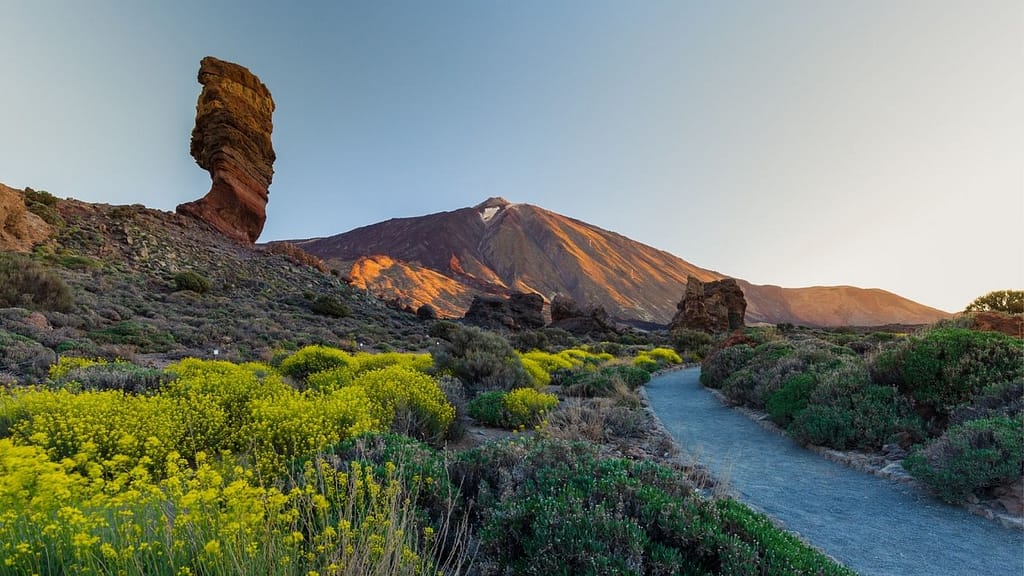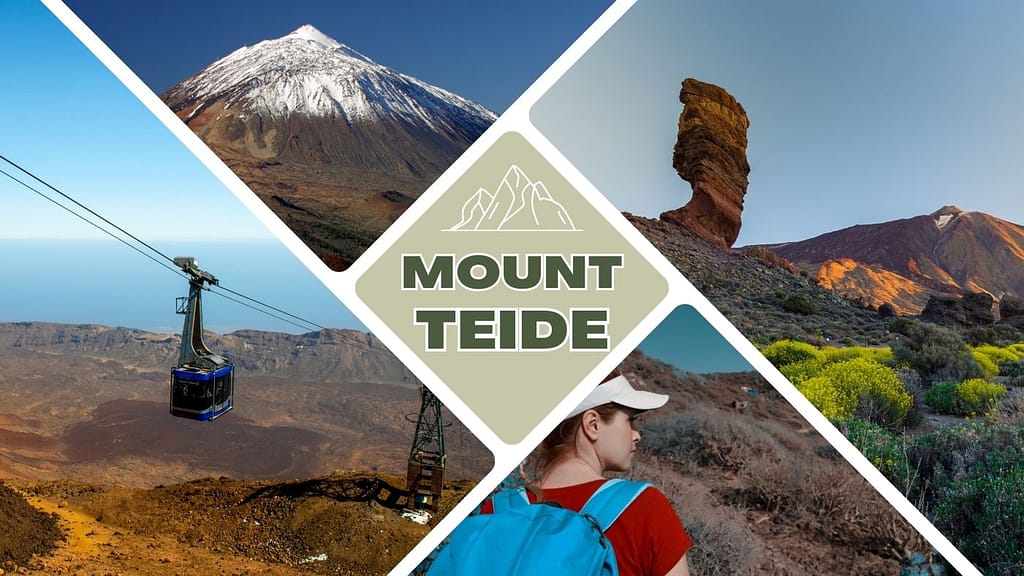Estimated reading time: 10 minutes
Tenerife’s Roques de García Guide: Hiking Trails and Natural Beauty
Embark on a Tenerife adventure around the Roques de García area! Discover volcanic wonders, hiking trails, and iconic rock formations in this geological masterpiece.
Roques de García is a breathtaking natural attraction located in Tenerife, Spain. It is a popular destination for tourists, nature enthusiasts, and hikers alike.
The unique rock formations of Roques de García are a result of erosion caused by volcanic activity, making it a must-see for anyone interested in geology.
The Roques de García hiking trail is a popular activity for visitors to the Teide National Park. The trail offers stunning views of the surrounding volcanic landscape, including the Pico del Teide and Mount Guajara.
The trail is suitable for hikers of all levels, with varying degrees of difficulty depending on the route taken. It is important to take into account weather conditions and to come prepared with proper hiking gear.
Location and Geology of the Roques de García
Roques de García
Roques de García is a group of rock formations located in the Las Cañadas del Teide Caldera, which is a large depression of about 16 km that surrounds the highest peak of Tenerife, El Teide or Mount Teide.
The caldera floor itself is about 2000-2300 meters above sea level, and the Roques de García is situated in the heart of the Mount Teide National Park, a UNESCO World Heritage Site since 2007.
The Roques de García formation belongs to the Lower Group and forms the morphological and structural barrier that divides Las Cañadas Caldera into two morphological depressions, the eastern side is 150 m higher than the western one.
The formation is composed of proximal facies of pyroclastic and sedimentary deposits, predominantly breccias, all of which are intruded by a dense network of monolithic dikes and necks.
The volcanic landscape of Roques de García and the surrounding area is a result of the activity of the Teide-Pico Viejo volcanic complex, which is considered one of the most important and active volcanic systems in the world.
The complex consists of three main volcanic edifices: Teide, Pico Viejo, and Montaña Blanca, as well as several smaller volcanic cones such as Guajara.
The Las Cañadas del Teide Caldera, where the Roques de García is located, is the result of several volcanic eruptions that occurred over the last million years. The most recent eruption took place in 1909, and it was a small phreatic explosion that originated from a vent located near the summit of Mount Teide.
Roques de García rock formations in Teide National Park

As I explore the Teide National Park in Tenerife, I am struck by the impressive rock formations known as Roques de García. These rocky delights are a sight to behold, and I feel compelled to learn more about their formation and erosion.
Formation
Roques de García is a collection of volcanic rocks that were formed millions of years ago during the explosive eruptions of Mount Teide. The rocks were ejected from the volcano and landed in the surrounding area, creating a unique landscape that is now a popular tourist destination.
One of the most famous formations in Roques de García is the Finger of God, also known as the Stone Tree. This towering rock formation resembles a tree without leaves or fruit, and it has become an iconic symbol of the Teide National Park.
Erosion
Over time, the elements have taken their toll on the Roques de García, and erosion has played a significant role in shaping the landscape. Wind, rain, and temperature changes have all contributed to the gradual erosion of the rocks, creating unique shapes and textures.
Despite the erosion, the Roques de García remains a stunning sight, and visitors from around the world come to marvel at their beauty. The Finger of God, in particular, is a must-see attraction that never fails to impress.
As I continue to explore the Teide National Park, I am struck by the power and beauty of nature. The Roques de García are a testament to the enduring force of volcanic activity and the relentless power of erosion.
Hiking Trails around Roques de García
As I explored Roques de García, I found that the hiking trails were one of the main attractions of the area. There are several trails to choose from, each with its unique features and challenges.
Mirador de la Ruleta

One of the most popular hiking trails in Roques de García is the Mirador de la Ruleta trail. This easy circular itinerary covers 3.5 km and takes approximately two hours.
The trail starts at the Mirador de la Ruleta scenic viewpoint and descends to the Ucanca Plains, the largest valley in the national park.
Along the way, hikers can enjoy stunning views of Roques de García to the left.
La Cascada

For those looking for a more challenging hike, the La Cascada trail is a great option.
This trail is approximately 5 km long and takes about three hours to complete. The trail starts at the Roques de García parking lot and leads hikers through a beautiful pine forest to the La Cascada waterfall.
The track is steep in some places, but the views are well worth the effort.
El Torrotito
Another great hiking trail in Roques de García is the El Torrotito trail. This trail is approximately 2 km long and takes about an hour to complete.
The route starts at the Roques de García parking lot and leads hikers through a rocky landscape to the El Torrotito rock formation. The trail is relatively easy, but hikers should wear sturdy shoes as the terrain can be uneven.
El Burro
The El Burro trail is a short but challenging hike that leads hikers to the El Burro rock formation. The trail is approximately 1.5 km long and takes about an hour to complete.
The track starts at the Roques de García parking lot and leads hikers through a rocky landscape with steep inclines. The views from the top are breathtaking and well worth the effort.
Overall, Roques de García offers a variety of hiking trails for hikers of all skill levels. Whether you’re looking for an easy stroll or a challenging hike, there’s something for everyone in Teide National Park.
Attractions Tenerife
Mount Teide and Pico Viejo

Mount Teide and Pico Viejo are the two highest peaks in the Canary Islands, both located in the Teide National Park.
Mount Teide is the highest peak in Spain, standing tall at 3,718 meters, while Pico Viejo has an elevation of 3,135 meters. These volcanic peaks have been formed by millions of years of volcanic activity and have become iconic symbols of Tenerife.
The ascent to Mount Teide is a challenging but rewarding experience. There are several hiking trails to reach the summit, and the most popular one is the Telesforo Bravo trail, which starts at the Montaña Blanca parking lot.
The route is well-marked and takes around 4-5 hours to complete, depending on your fitness level.
The views from the summit are breathtaking, and on a clear day, you can see the neighbouring islands of La Gomera, El Hierro, and La Palma.
Pico Viejo is another impressive peak in the Teide National Park. It is located next to Mount Teide and is part of the same volcanic complex.

The hike to Pico Viejo is shorter than the one to Mount Teide, but it is still challenging due to the steep terrain.
The trail starts at the Parador Nacional de las Cañadas del Teide and takes around 2-3 hours to complete.
The highlight of the hike is the panoramic view of the multicoloured crater, which is around 800 meters in diameter.
Both Mount Teide and Pico Viejo are stunning natural wonders that attract thousands of visitors every year.
It is essential to respect the environment and follow the rules and regulations of the Teide National Park.
Visitors are required to obtain a permit to hike to the summit of Mount Teide, and it is recommended to book in advance due to the limited number of permits available.
Book permit here at Reserva de Parques Nacionales website.
Roque Cinchado and Roque Blanco Rock Formations

Roque Cinchado and Roque Blanco are two of the most famous rock formations in the Roques de García area.
Roque Cinchado is also known as the “Finger of God” or the “Stone Tree” due to its unique tree-like shape, while Roque Blanco is a towering white rock formation that stands out against the dark volcanic landscape.
To reach Roque Cinchado, visitors can take a short hike from the Roques de García parking area. The trail is well-marked and offers stunning views of the surrounding mountains and valleys.
As you approach Roque Cinchado, you’ll be struck by its towering presence and the intricate details of its rock formations. Be sure to bring your camera, as this is one of the most photogenic spots in the area.
Roque Blanco, on the other hand, is best viewed from a distance. This towering white rock formation stands out against the dark volcanic landscape, and its unique shape and size make it a popular spot for photographers.

Visitors can get a great view of Roque Blanco from the Mirador de la Ruleta viewpoint, which is located just a short drive from the Roques de García parking area.
Both Roque Cinchado and Roque Blanco are incredible examples of the unique geological formations found in the Roques de García area.
Whether you’re a geology enthusiast or just looking for a beautiful spot to take some photos, these two rock formations are not to be missed.
Plan Your Vacation with these useful links
- Find a flight
Kiwi.com – Helping you to find the cheapest airline tickets.
- Find an accommodation
Welcome to Tenerife. Enter your check-in date and choose from 9628 properties with Booking.com!
- Order taxi transfers from airports and hotels
Kiwi Taxi. Immediate departure, the driver meets you, pay online or in cash.
- Book Your Activities
Top sights you can’t miss in Tenerife! GetYourGuide.
- Rent a Car: Search, Compare, Save
Join now the many satisfied customers of Rentalcars.com – the leading car rental comparison website around the world. Only 3 steps separate you from “four wheels”!
- Ekta – is a new-generation insurance company that combines competitive prices with a high level of service.
You will receive your insurance policy by email within 2-3 minutes. There is a multilingual technical support chat 24/7.
